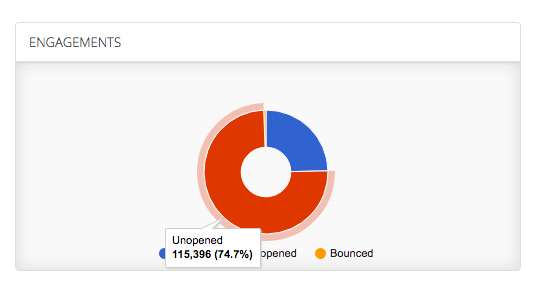Email deliverability is a complicated equation. Controlling as many variables as possible is a sound plan, and we also implore users to have realistic expectations when changing to a new service, testing new tactics, or making any additional changes. We’ve recorded a podcast on the topic, and there is still plenty more to cover.
Deliverability is the measurement of an email’s success in reaching a contact’s inbox. Overall email deliverability is impacted by many factors, including list quality, reputation, content, and identification as spam. Because there are so many factors, improving deliverability is a constant goal, an eternal battle to improve upon past performance, employ lessons learned, and run new tests moving forward.
Remember The Basics
When it comes to deliverability, the inbox success metric includes anything that is NOT in the spam or trash folders. In the case of popular services like Gmail, emails that surface in the “Promotions” tab are still considered a successful delivery.
There are several deliverability metrics:
Open Rates: A simple percentage of how many people open an email. However, this data can be deceiving. An email opened does not indicate an email read. In the graph below, the open rate is 24.7%, but the read rate may be lower.

Complaint Rates: A complaint rate is how often your messages are marked as spam.
This could occur more frequently if you contact a list of people who did not organically opt into your messages, but instead you purchased a list, for example. ActiveCampaign suggests utilizing an opt-in form whenever possible, avoiding the potential fallout of such lists. A double opt-in form can provide even better results.
If contacts repeatedly mark you as spam, and you haven’t bought a list, then you should take a look at message content and frequency. Make sure your audience receives the types of communication they want and expect, from the people they want to hear from.
In the graph below, there are a large number of unopened emails. There is no way to tell how many may have marked you as spam, so if you regularly have emails with large unopen rates, and your bounce rate rises over time, you may be sending the wrong type of content, or too many emails. 
Bounce Rates: The rate at which emails fail to reach an inbox, or bounce, negatively impacts your sender reputation. This is another argument against purchasing contacts, as you may inherit incorrect or inactive email addresses. In the graph below, the email sent had a very low bounce rate percentage, which likely indicates a healthy list.

Spamtrap Hits: Spamtraps are email addresses that published only in a hidden location, for the purpose of luring spam. These addresses can be picked up in an email harvester, and any email they receive is marked as unsolicited spam. Often times, emails that are no longer active are converted into spamtraps, so a purchased list with outdated information could lead to more problems.
Delete Without Read Rates: Many Email Service Providers (ESPs) are now tracking how many emails are deleted without being opened. Email marketing should be carefully scaled and tested to avoid over-saturating contacts, inspiring people to click the “Delete” button immediately.
Migration Challenges
If you migrate to ActiveCampaign, or any service that delivers emails, you may see an initial dip in deliverability rates immediately following the migration. To see that dip in performance is completely normal, and your rates should revert to the norm and improve over time. There are several factors at play:
- Your emails now come from a new IP address; you need to develop a reputation for high-quality sending. If you’ve always sent solid communications, then you should be able to build your reputation quickly. Just know that you may have a few more deletes and soft-bounces in the beginning.
- Some businesses use a new email service/migration as a reason to purchase a list of “fresh” leads. Those leads did not opt-in and may lead to several people marking your messages as spam. They may also bounce, or you may unintentionally hit spamtraps.
Some suggestions to minimize this dip include:
- Don’t send too much email, too fast. Warm up your contacts to your new “home.” The larger the list, the bigger the potential for issues.
- Keep content messages and sender information as steady as possible during this time. Give your contacts time to recognize that you are still you, and let them remember that they enjoy opening your emails.
- Send to your most engaged leads first. They already trust you and expect to hear from you, so they are the most likely contacts to open your communications and quickly boost your reputation.
A Complicated Equation, A Simple Solution
Successful email deliverability metrics will always be a goal, and the parameters for success will continually shift. The good thing about these constant changes is that they reward marketers who send real content to contacts who want to receive it. Marketing best practices and common sense generally leads to wins in deliverability.
We’d love to hear about your deliverability challenges and successes. Share them below!
